High Altitude Balloon Flights Carrying HF Radio Telemetry
A miniature HF telemetry transmitter flying under a 'super pressure' party balloon.
After tracking recent Picospace balloon flights I got 'the bug' to fly some more of my own balloons. This time the aim is to reduce payload weight to gain extra altitude while still flying under a 36" diameter party balloon at a minimal cost. The following flights use lightweight 'tracker/telemetry' transmitters built following the concept of the QRP-Labs U3S transmitter, and running a modified version of QRP-Labs U3S firmware.
Link to past flights BB01 to BB05 Link to flight BB07
Link to flight BB07 Link to flight BB08
Link to flight BB08 Link to flight BB09
Link to flight BB09 Link to flight BB10
Link to flight BB10

Balloon Flight BB06 (ZL1RS) - from 25 March until 31 March 2020
UPDATE 01 and 02 APRIL 2020
No decodes for two days, and no off-timed signals were seen by helpful ZS Ham Radio operators or on 3 different remote receivers in ZS. So BB06 is delcared 'down' and BB07 is now flying!
The overall track for the BB06 flight from 25 March to 31 March 2020:
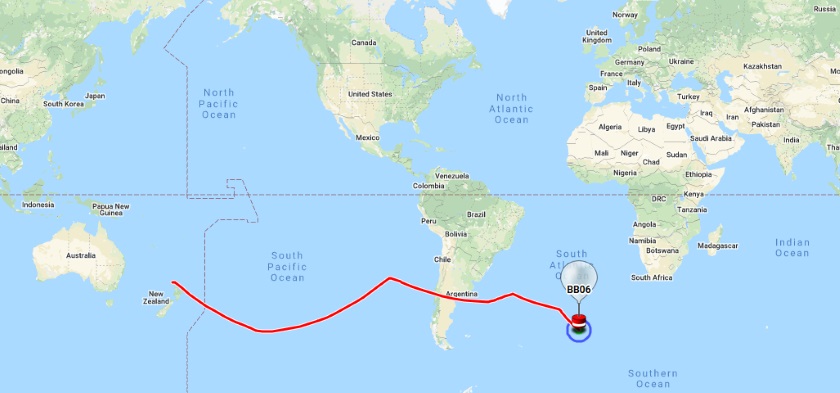

UPDATE 31 MARCH 2020
From 10:44 until 14:30 UTC ... BB06 was 'awake' and transmitting on time so the GPS was working today.
14:00 UTC ... the jet stream is very fast at the present location in the southern Atlantic Ocean and BB06 is travelling at around 260 km/hr! This condition is usually associated with low air pressure in the region which has the effect of reducing the flight altitude ... earth.nullschool.net shows the surface air pressure at 994 hPa, and BB06 is currently flying at around 9940 meters ASL but should recover some altitude tomorrow with the 1013 hPa air pressure in the area south of South Africa and Madagascar.

UPDATE 30 MARCH 2020
From 12:44 until 17:51 UTC ... BB06 was 'awake' and transmitting on time (so the GPS was working today).

UPDATE 29 MARCH 2020
From 15:14 UTC ... BB06 is 'awake' and transmitting on time, so the GPS is working today. No update to Habhub for the moment, but it appears to be at locator EF17oc travelling at 140km/hr and floating at 10.340m ASL. More to follow ...
18:30 UTC ... The customised settings I had in the M7REG WSPR telemetry script were a little bit too 'economical' to cope with the larger number of 20m WSPR spots now that propagation in general has improved (equinox propagation peak). The settings have been re-adjusted to cope, and both Habhub and APRS tracking are working.
The anticipated track and transmission times for 29/30/31 March and 01 April:
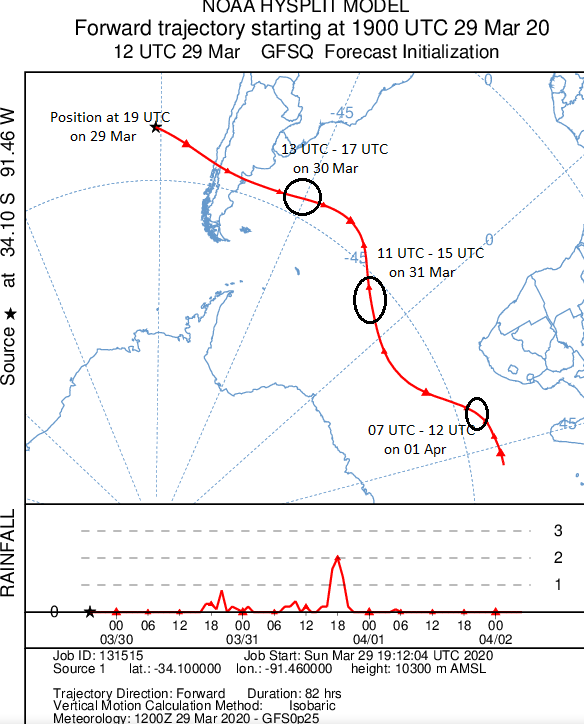

UPDATE 28 MARCH 2020
From 17:36 UTC ... BB06 started transmitting off-time indicating that the GPS has 'frozen' again today. Nothing to do except hope for better tomorrow. I have devised a GPS reset method for the next flight, BB07!
The anticipated track and transmission times for 28/29/30 March:
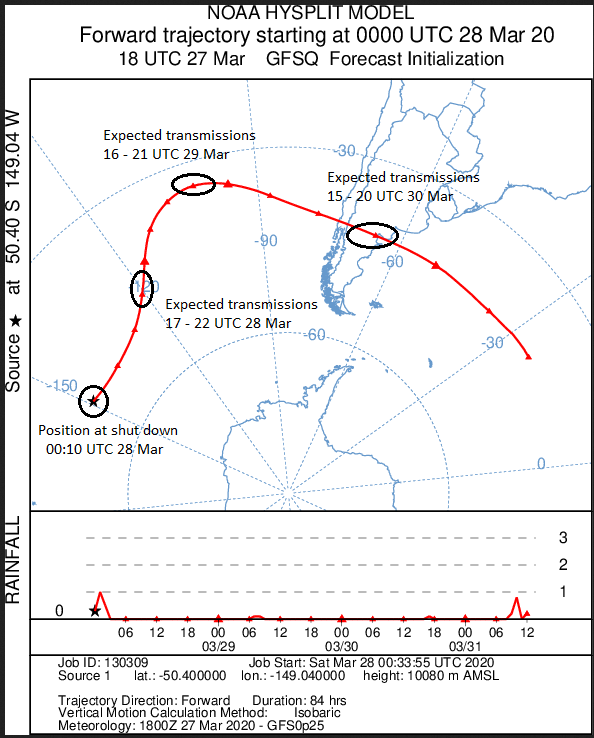

UPDATE 27 MARCH 2020
From 20:00 UTC ... for the last 20 to 30 minutes BB06 has been sending partial WSPR transmissions then cutting out. This indicates insufficient sun on the solar cells, so the location may be further south than anticipated. At least the timing is correct for those bursts of signal (starting at exactly :x4 minutes) which means that the GPS is working today. More as it happens ...
20:40 UTC ... a full set of transmissions and an update

UPDATE 26 - 27 MARCH 2020
There was a problem with the GPS today. Either it locked up when starting, or it has failed altogether. As a result BB06 was transmitting off schedule with no GPS related data updates. By sheer luck the timing error was almost exactly 2 minutes, so WSPR and JT9 decodes were possible without adjusting the computer time. A GPS module behaved similarly on a previous flight and recovered the next day, so we wait to see if BB06 does the same.
Going by the 'wake up' time and the 'shut down' time relative to sun angle, BB06 is more or less on the track indicated by the trajectory prediction (about 2000 to 3000km east of New Zealand). If BB06 has survived the area of bad weather around that location, the next wake up time is anticiapted between 19 and 20 UTC on 27 March.

LAUNCHED AT 23:15 UTC ON 25 MARCH 2020
BB06 climbed steadily to almost exactly the predicted float altitude of 10,400m (34,100 feet)
Shut down this evening at 03:50 UTC with 24 to 25 degrees of sun elevation remaining (same as when tested on the ground)
There is a problem with the tracking on Habhub ... no updates since the altitude exceeded 10,000m ... working on it
The tracking on APRS is working normally
The next 'wake up time' is anticipated at around 19:30 - 20:00 UTC ... if it survives through the night.
Here are the JT9 decodes from the last 30 minutes before shut down this evening ...
200326_031800 - ZL1RS RF75TC
200326_031900 - 355 A23 10406
200326_032000 - 35.03 68.77
200326_032800 - ZL1RS RF75UD
200326_032900 - 355 A23 10381
200326_033000 - 32.48 69.28
200326_033800 - ZL1RS RF75VE
200326_033900 - 356 A23 10365
200326_034000 - 32.34 69.18
200326_034800 - ZL1RS RF75WF
... see below for an explanation.

BB06 over view:
Balloon: a 36" dia 'Chinese clear' balloon with enough hydrogen gas to provide 3.5 to 4 grams of free lift over the total payload weight
Payload: a QRP-Labs U3S based transmitter sending 20mW of WSPR mode tracking and JT9 mode information on the 20m band
Antenna: a halfwave dipole (0.1mm dia wire) supported on 4 pound fishing braid, with the transmitter suspended at the feed point
Total payload weight (transmitter + antenna): 3.98 + 0.93 = 4.91 grams
The tracker transmitter is 'flying naked' ... there is no insulation or other coating on the PCB
Anticipated 'float altitude': 10,400m
BB06 hardware compliment:
GPS - ATGM336H
Processor - ATmega328P-AU
Processor clock - 8MHz
Synthesiser - Si5351a
Synth reference - 27MHz TCXO
Solar cells - four 39mm x 19mm 0.12W solar cells in series producing about 2.2V in bright sunshine
Voltage regulator - CE021 'charge pump' boost regulator with 3.3V output
Transmitter frequency:
The WSPR and JT9 signals are received with a receiver tuned to the standard 20m band WSPR 'dial frequency' of 14.095600 MHz. The WSPR appears on the waterfall in the upper half of the WSPR passband (at about 1565Hz), and the JT9 appears about 130Hz higher (see the screen shot in the pictures below).
Transmitter schedule:
Minute Transmission Transmission
:x4 Standard WSPR mode - callsign ZL1RS Standard WSPR mode - callsign ZL1RS
:x6 WSPR telemetry - callsign 0*2*** (channel 02, * are characters generated by the telemetry) WSPR telemetry - callsign 0*2*** (channel 02, * are characters generated by the telemetry)
:x8 JT9 plain text using QRP-Labs U3S tags #CS #M6 (Call sign, 6 character Maidenhead locator) JT9 plain text using QRP-Labs U3S tags #CS #M6 (Call sign, 6 character Maidenhead locator)
:x9 JT9 plain text using QRP-Labs U3S tags #A0 #A3 #AT (not used, not used, Altitude) JT9 plain text using QRP-Labs U3S tags #A0 #A3 #AT (not used, not used, Altitude)
:x0 JT9 plain text using QRP-Labs U3S tags #GS #GC (Speed in knots, Course in degrees true) JT9 plain text using QRP-Labs U3S tags #GS #GC (Speed in knots, Course in degrees true)
#A0 and #A3 (temp and volts) are not used on BB06. #AT, #GS and #GC are from the GPS output strings.
Decoding and tracking:
The WSPR telemetry capture, decoding and forwarding is done by a version of Aaron M7REG's python script (forked from SM3ULC) with further modifications by Andy VK3YT and myself. Thanks also to Jim N2NXZ for the set-up tips that saved a lot of potential grief.
Tracking on Habhub
Tracking on APRS
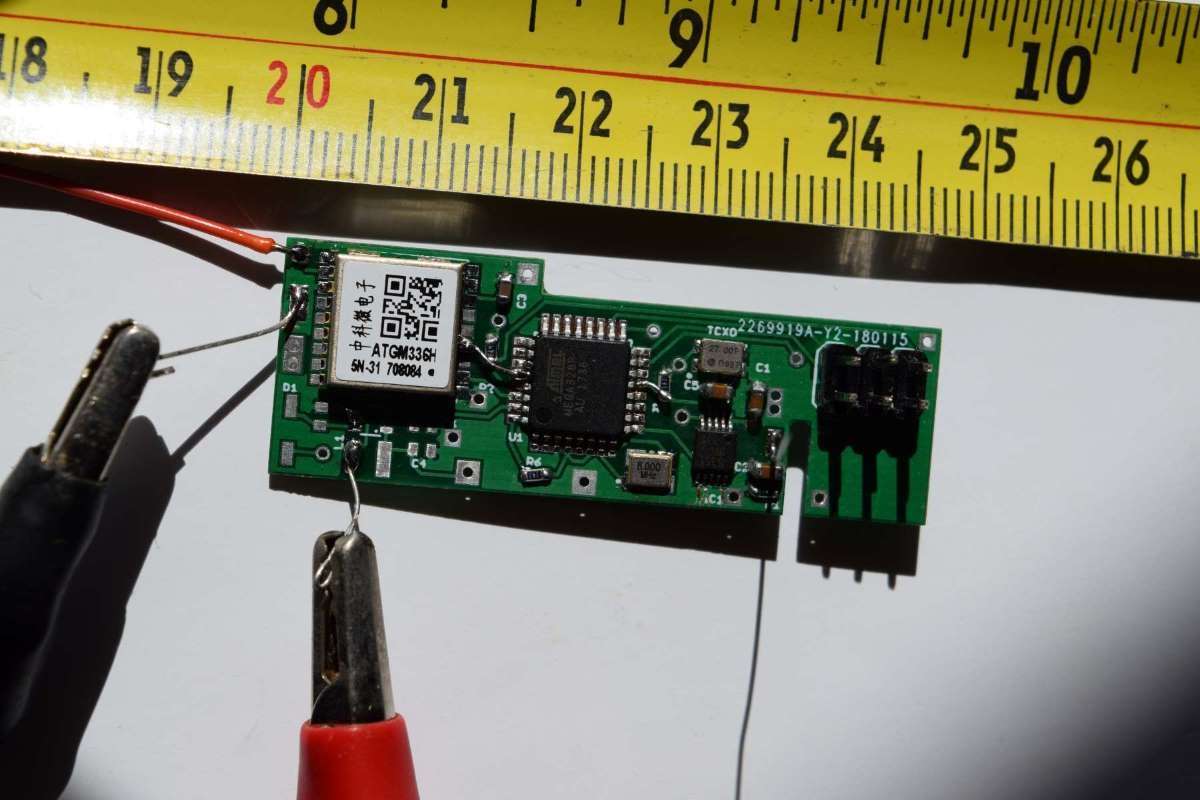
BB06 uses a PCB gerber file from SA6BSS with an omitted track bridged by wire. The 6-pin ISP header at the right hand end is cut off prior to flight
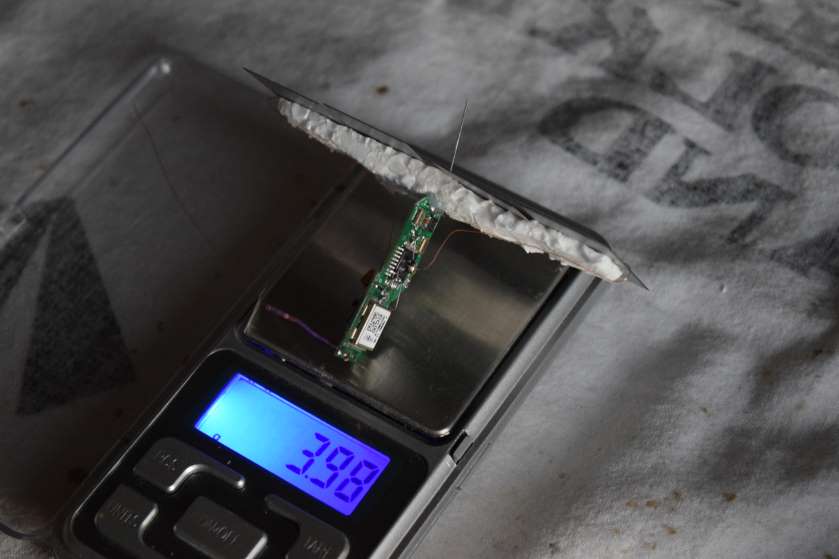
The completed transmitter board with a boost regulator and 270uF SMD tantalum capacitor mounted under the PC board. Four 39mm x 19mm solar cells are mounted on a polystyrene 'carrier' ... combined weight = 3.98 grams
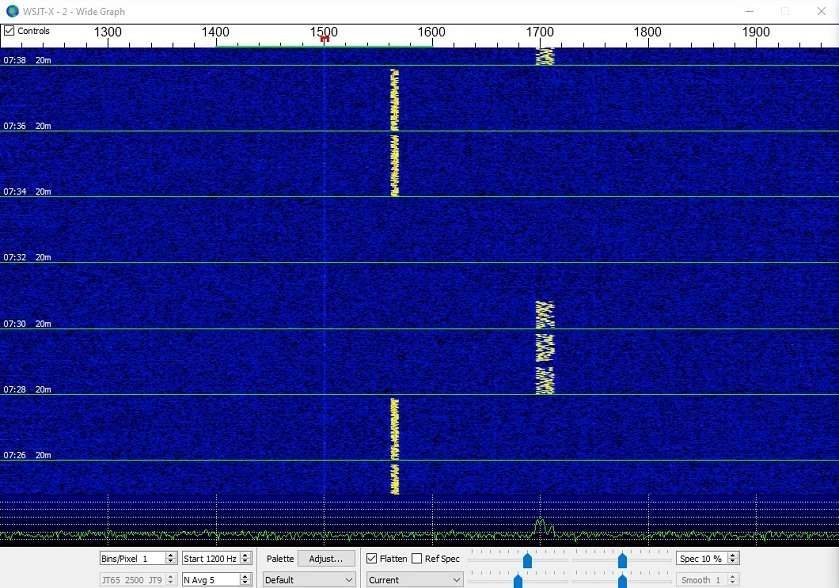
WSJT-X waterfall screen shot showing WSPR at 1565Hz and JT9 at 1700Hz
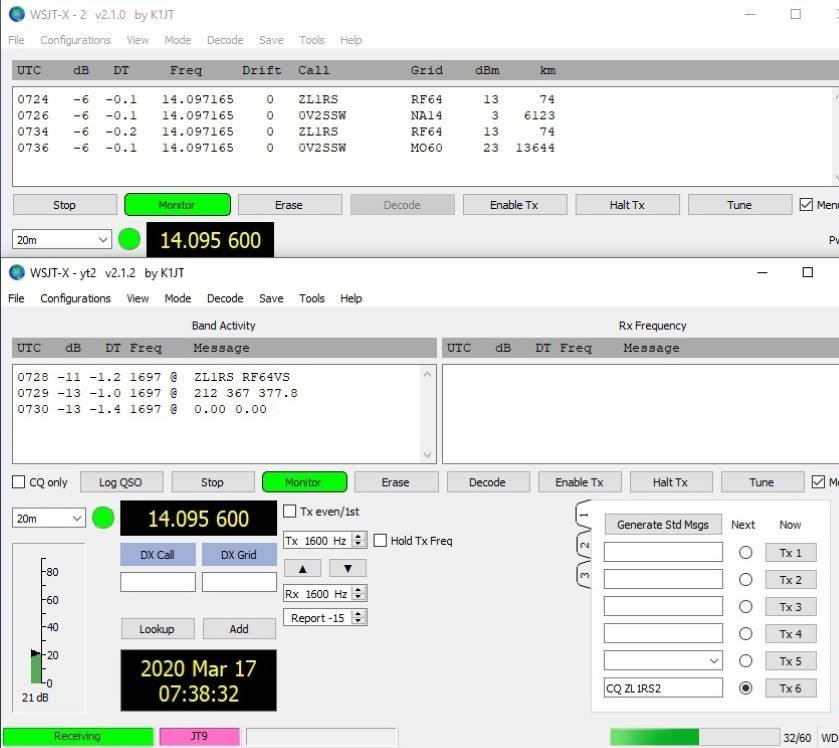
WSJT-X WSPR and JT9 decodes

|






